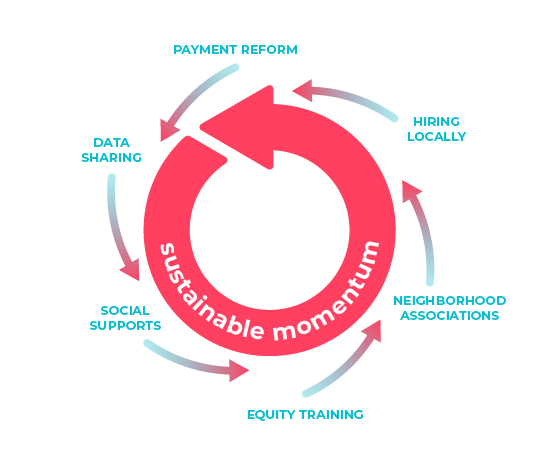How to Design a Self-Sustaining, Comprehensive Healthcare System
At 20-something years old, I had two young children and a part-time job in a diner. When sickness hit, it was a triple whammy. With no health insurance, no paid sick leave, and no childcare so I could rest, it took me longer to recover. My children would inevitably catch the same illness, continuing the downward spiral. To make up for lost pay from missed shifts and cover medical bills, we turned the heat down and bought cheaper (less nutritious) food, which made it even harder to stay healthy. Nobody slept well. You get the picture.
Health requires a set of conditions and opportunities that replace these types of downward spirals with a flywheel. A flywheel is a heavy, revolving wheel in a machine that increases the machine’s momentum and stores energy reserves that smooth out irregularities in power. Because the flywheel is heavy, it requires a lot of initial energy to bring it up to speed, but once spinning, it takes little effort to keep it in motion.
With the right supports in place, we can create a flywheel effect to improve health and wellbeing for everyone.
Our healthcare system has been stymied by a flawed payment model that prioritizes patient volume over addressing root causes of poor health. We treat illnesses without coordinating comprehensive strategies for overall population health.
But this is about to change. Alternative payments are increasingly replacing fee-for-service models with ones that pay primary care providers to address the community and social conditions that affect health. Alone, these payment models will not be sufficient, but they offer a promising increase in momentum.
Specifically, North Carolina is rapidly shifting to value- and population-based care, potentially the most ambitious statewide effort in the country. I am especially interested in the state’s work to transform Medicaid payment structures so that primary care providers can actively mitigate health barriers related to housing, food security, transportation access, and interpersonal safety. Under these reforms, primary care providers will receive fixed pre-payments to cover traditional visits, plus extra to pay for things like replacing moldy carpets or fixing air conditioners when housing conditions cause repeated asthma attacks. Taxi vouchers are another example, enabling patients to access food pantries or keep their medical appointments. There are also plans to coordinate referral and data-sharing systems across social service agencies and other community-based social supports.
However, while these types of assistance address critically important gaps, they don’t address the conditions that cause those gaps in the first place. So yes, policy makers and health care professionals should keep building the flywheel’s momentum with payment reforms and better coordination of social service supports. But they must also change conditions and resources within communities to maintain health and wellbeing over a longer term. Only policies that support affordable and safe housing, quality education, paid sick leave, livable wages, multi-modal transportation options, and more, will provide the metaphorical flywheel with the inertia necessary to sustain a system of full health, not just care.
And to do this, cross-sector community partnerships (including healthcare leaders) must simultaneously invest in three additional strategies:
Training.
The ambitious plan for health care reform in NC (and any state that attempts similar reforms) must include an analysis of how biases and structural racism have created inequities that disproportionately affect people of color. Discriminatory practices, structures, and institutional policies have contributed to health disparities. These injustices require customized responses that address the trauma of this history, change the resulting conditions, and build trusting relationships with the people who’ve been harmed.
Supporting neighborhood associations.
Local health systems should support capacity-building among community members to help create community-driven, long-term changes to policies, systems, and environments. Partner organizations should support the priorities of residents, rather than simply asking residents for feedback on their priorities. See my last blog on shifting power to patients.
Hiring locally.
As payment reforms enable structural support for community health workers, navigators, and other community-based liaisons, healthcare institutions should hire from within the communities they serve. Not only does this provide needed jobs, but it more effectively addresses inequities. Trust is more easily established, and these health navigators have a deeper understanding of the challenges and solutions to them within their own communities than outside staff would.
By investing in these three strategies, along with the impressive structural changes already taking place, we can drive the flywheel to a sustainable force that keeps all places healthy by design.
